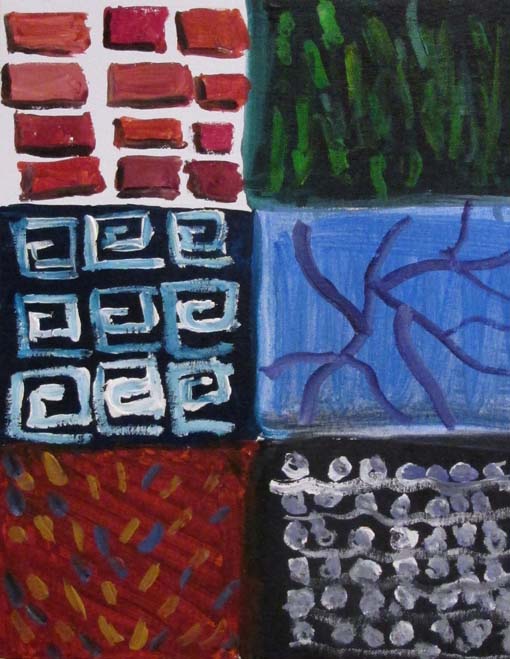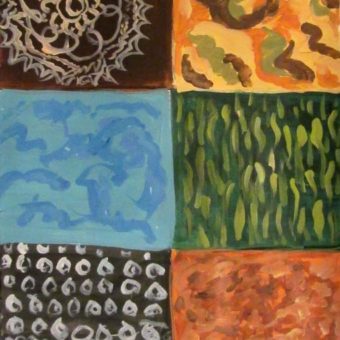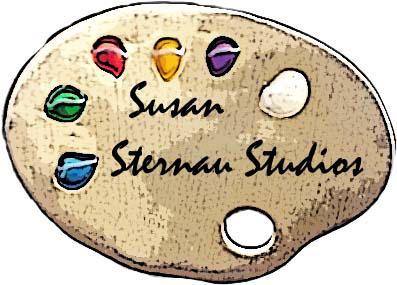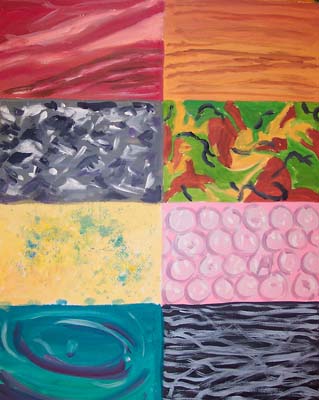Art Project, Easy Art Project
Textures and Patterns Lesson
Introduction to Textures and Patterns:
Textures and patterns are eye-catching and add interest to paintings and drawings. This exercise is a great way to build skills and strengthen your powers of observation of textures and patterns. It will get you to start looking at the world of everyday things around you in a different way. The textures and patterns you feel confident drawing or painting will become part of your artist’s vocabulary. They’ll help you add variety and visual excitement to your work.
As you begin to paint or draw textures, you’ll notice that many textures create their own patterns. It follows that texture and pattern are closely related in the world of illusion that is two-dimensional art. Patterns are repetitions of shapes, colors and/or contrasts and are enjoyable to look at. Everything has texture. Start noticing and appreciating the variety around you. Is something smooth and shiny, rough and bumpy, silky and soft, or furrowed and cracked? Each texture you feel can be translated into a pattern that creates the illusion of texture on your paper or canvas.
The Merriam-Webster dictionary defines texture as the way something feels when you touch it, the way food or drink feels in your mouth, or the way parts of a song, poem or movie fit together.
So you should be aware that texture also has emotional and physical components that can add richness to your paintings by reminding people of various sensations. Pattern is defined as a repeated form or design especially that is used to decorate something. Many painters throughout the history of art have used patterns from fabrics as an element in their paintings. The paintings of Matisse are a great example of this, and I’ve written about it in my book Henri Matisse.
For another art educator’s approach to this subject have a look at Julie Voigt’s excellent post “Painting – Textures & Patterns” in Art for Small Hands.

Materials You’ll Need:
- Collect a variety of real things and photos to work from. Look through your own photos, find pictures in magazines or search for images on-line and print them out for reference. Fill some bowls or plates with things that interest you, collect samples of textures indoors and outside such as sea shells, pinecones, bark, a pineapple, a bowl of blueberries.
- Some other ideas for texture are wood grain, a plate of rice, cracked mud, a sponge, wood chips, cotton balls, a woven basket, marble, camouflage pattern, bubble wrap, dry grass, water ripples, lace, printed fabrics, woven fabrics, decorative objects, and crumpled foil.
- Acrylic paint and brushes
- Water jar for brushes
- Paper palette
- Canvas or heavy watercolor paper
- Pencil and ruler

Textures and Patterns Lesson Steps:
- Divide your paper or canvas into six or more boxes with the pencil and ruler.
- For each texture box, focus on finding and painting the “underneath color” to use as a base color in your acrylic painting. Mix and paint the base color for each texture in one of the boxes of your grid until they are all painted.
- When the base color is dry continue painting a top layer that describes the texture. Do this by closely observe the texture of the thing you are painting. Look for contrasting colors. Identify repeating lines or shapes. Note highlights and shadows. When painting note the direction and relationship of small and large shapes and try to mentally summarize the texture. Is it all hard edges, soft edges or a combination? Do the shapes line up in certain directions or seem totally random?
- Study the texture and break it down into simpler shapes in your mind. How often does the pattern repeat itself?
More things to notice:
You may start noticing that many textures and patterns in nature are related. Clouds look like cotton balls or certain flower clusters. Wood looks like stone or like eroded hillsides in the distance. Have fun enjoying the world of textures and patterns. Can you paint a texture so real someone wants to reach out and touch it?

